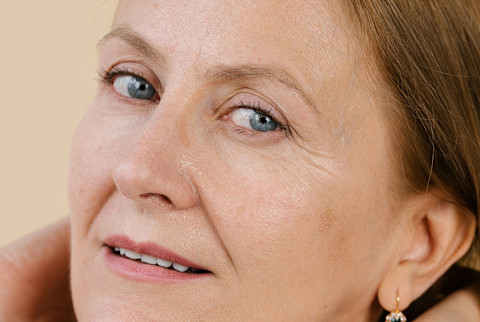Soy Protein Reduces Wrinkles In Postmenopausal Skin, Study Finds

Healthy skin aging starts from within, but it's not quite as complex as you might think. In fact, a skin-supporting diet looks a whole lot like eating for overall longevity: prioritizing whole, natural foods; getting enough protein; and eating antioxidant-rich meals.
That being said, research has begun to show that some foods actually do have a direct influence on skin aging, making the case for "skin foods" stronger than ever.
To come, a natural protein most recently added to the list.
Research suggests soy protein may reduce wrinkles
A study published in the journal Nutrients found that dietary soy protein supplementation with isoflavones may improve skin photoaging1, including wrinkles and pigmentation concerns, and increase skin hydration in postmenopausal women.
Isoflavones (also known as phytoestrogens) are plant-based components found in foods like soybeans that mimic a similar action of estrogen in the body—hence, why they may be so beneficial during a time when women experience the most significant dip in estrogen (aka, after menopause).
How did researchers come to this conclusion? Here are the deets:
- The study analyzed 44 postmenopausal women, comparing the effect of protein from dairy milk to protein from soy. Researchers analyzed factors such as wrinkle depth, skin pigmentation, skin hydration, and sebum production throughout the 24-week-long study.
- They concluded that all factors apart from sebum production were positively impacted by soy protein intake compared to milk-based protein.
- The study included the use of soy protein containing 50 milligrams of isoflavones—which equates to about half a cup of calcium-set, firm tofu, or 2 cups of soy milk2.
Now, there are a few things to call out here: First, the study only measured white women, specifically women with Fitzpatrick skin types I, II, and III—which means pale skin, fair skin, and light-to-medium white skin. So, for these results to be confirmed across all skin tones and skin types, we need more research.
Next, the exact reasons behind the skin improvement may be multifaceted. First, researchers note that these isoflavones may promote cell proliferation, act as antioxidants, and exert anti-inflammatory3 and anti-cancer4 properties in the full body.
On that note, there's a common fear that isoflavones found in tofu may increase the risk of cancer in postmenopausal women. However, a comprehensive review from the European Food Safety Authority (EFSA) concluded that isoflavones do not increase the risk of breast, thyroid, or uterine cancer risk in postmenopausal women.
Still, if you have any lingering concerns, we suggest consulting a health care professional before making any changes to your diet.
In the skin, isoflavones and other phytoestrogens have been shown to increase hyaluronic acid concentrations and improve the content and quality of collagen—both of which decline naturally with age, contributing to drier, looser skin over time.
However, soy protein is just one piece of the puzzle when it comes to building a skin-supporting eating pattern. You'll want to ensure you get enough carotenoids (most often found in orange and red produce, like carrots and bell peppers), as well as omega-3s (found in salmon, avocado, walnuts, etc.).
If you really want to level up, consider adding collagen peptides to your diet as well—these have been shown to support skin elasticity and dermal density5, which directly impacts the look and feel of aging skin. Here, the best collagen supplements on the market for skin and gut support.
3 ways to prepare soy-rich foods
Tofu can be a difficult food to master if you're not super familiar with it already. Below, three easy ways to get more soy in your diet (and actually make it taste good):
- Classic tofu cubes: Tofu cubes are probably the easiest way to eat the silky protein—but the right preparation will make or break your recipe. Make sure you press your tofu before using it to eliminate excess water, and consider tossing it in olive oil and spices for a subtle crispy texture.
- As a snack: If you just can't get past the texture of tofu, you're certainly not alone. You can still reap the benefits of soy via soybeans. Pop them in your salad or toss soybeans in soy sauce or coconut aminos for a salty snack.
- Shredded tofu: Personally, I think shredded tofu is the superior form. I would suggest pressing your tofu before shredding it, as excess water will make this process a whole lot messier. Utilize shredded tofu in tacos, sandwiches, warm bowls, and so on.
The takeaway
A study found that isoflavones found in soy protein may improve skin photoaging, including wrinkles and pigmentation, and increase skin hydration in postmenopausal women.
We can ascribe much of these benefits to soy's similar behavior to estrogen in the body, a hormone that dwindles during menopause. Don't love soy? No problem: Here are more great skin-supporting foods to add to the list.
5 Sources
- https://www.mdpi.com/2072-6643/15/19/4113#B10-nutrients-15-04113
- https://www.ncbi.nlm.nih.gov/pmc/articles/PMC5188409/
- https://www.sciencedirect.com/science/article/abs/pii/S0167527313004543
- https://pubmed.ncbi.nlm.nih.gov/24373791/
- https://jddonline.com/articles/oral-collagen-supplementation-a-systematic-review-of-dermatological-applications-S1545961619P0009X/
